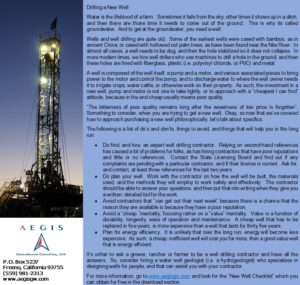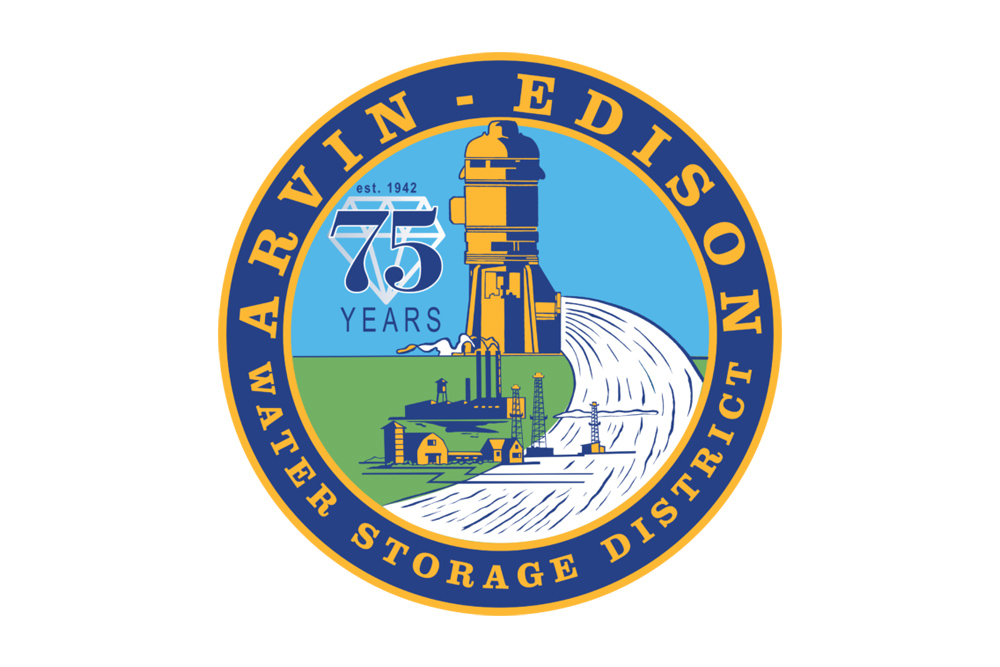 The Kaweah Delta Water Conservation District held its board of directors meeting on Tuesday, November 6, 2018 at its Farmersville headquarters. Chairman Don Mills called the meeting to order at 9:00am. There were no public comments and KDWCD General Manager Mark Larsen started things off with announcements. He said UC Davis is looking for growers with alfalfa willing to participate in a flood irrigation study. That’d be good to look into. Larsen was asked to speak to a school group about water rights and how things work locally. He said that worked out well and announced the PG&E/So Cal Ed water and energy day this Thursday from 8:00 am to 1:30 pm at the Tulare Ag Tech Center. The consent calendar was passed.
The Kaweah Delta Water Conservation District held its board of directors meeting on Tuesday, November 6, 2018 at its Farmersville headquarters. Chairman Don Mills called the meeting to order at 9:00am. There were no public comments and KDWCD General Manager Mark Larsen started things off with announcements. He said UC Davis is looking for growers with alfalfa willing to participate in a flood irrigation study. That’d be good to look into. Larsen was asked to speak to a school group about water rights and how things work locally. He said that worked out well and announced the PG&E/So Cal Ed water and energy day this Thursday from 8:00 am to 1:30 pm at the Tulare Ag Tech Center. The consent calendar was passed.
Shane Smith, Projects Manager showed the board the new and improved Kaweah Delta website. It’s much nicer visually and much easier to find information. Go check it out www.kdwcd.com
Victor Hernandez, Water Master reported helicopters are on the job to plant a 25 feet high pole in the high country to attach an antenna. This fix will keep snow information flowing through the 2019 season. Larsen said the NASA Aerial Snow Observatory flights are still on track for this year.
Larsen and engineer Dennis Keller said there is an opportunity to get Unreleased Restoration Flows with a contract for USBR. It’s $20 an acre foot, pretty good deal. Keller said if you sign the contract with the Bureau you pay for the water whether it’s delivered or not. The board approved entering into the contract pending approval after attorney Aubrey Mauritson looks it over.
Director Chris Tantau reported the last Friant Water Authority meeting laid out two options for  Friant Kern Canal subsidence repairs. There is a plan for a kind of second canal that runs beside it or reshaping the current canal. I unfortunately wasn’t there and I apologize to Tantau if I got it wrong. The other big Friant deal was the transition of the Temperance Flat Dam project from the San Joaquin Valley Water Infrastructure JPA to the Temp Flat MOU. It looks like the buy in is on hold at the moment, if I understood correctly. The Bureau has pulled back its position on Temp Flat in regards to restoration flows and will redo its assessment. Tantau said transferring title of the FK Canal itself from the federal government to FWA is still under investigation. Back to the FKC repairs, Kaweah Delta has some property that could help the repair.
Friant Kern Canal subsidence repairs. There is a plan for a kind of second canal that runs beside it or reshaping the current canal. I unfortunately wasn’t there and I apologize to Tantau if I got it wrong. The other big Friant deal was the transition of the Temperance Flat Dam project from the San Joaquin Valley Water Infrastructure JPA to the Temp Flat MOU. It looks like the buy in is on hold at the moment, if I understood correctly. The Bureau has pulled back its position on Temp Flat in regards to restoration flows and will redo its assessment. Tantau said transferring title of the FK Canal itself from the federal government to FWA is still under investigation. Back to the FKC repairs, Kaweah Delta has some property that could help the repair.
Vote, it’s important. Prop Three holds money for the repair of the FKC, drinking water for disadvantaged communities and funds to help growers with SGMA. It’s a water bond with water in it. Previous bonds have included money for soccer fields next to wetlands in Southern California and the Sierra Club was fine with that. Why? This was a so called environmental improvement. For some reason the professional enviros believe that only bonds that directly benefit them are valid water bonds. They must be scared of infrastructure improvements. And they have the gall to squeal about greedy, corporate farming. According to www.activistfacts.com the Natural Resource Defense Council has assets of more than $306 million in 2015. The Sierra Club has $113 million in assets as of 2015. This isn’t all donated money. Much of it comes from lawsuits. So, think for yourself when you vote. Know why and who you’re voting for.
The board listened to a presentation about increasing the district’s SCADA system. Aaron Fukuda, GM Tulare ID was asked if he had any regrets about any of the SCADA TID has installed. Fukuda said he has regrets about some of the equipment he’s purchased but not having SCADA.
There was also good news about the basin projects Kaweah Delta has been working on. Tantau said there is some benefit to the FKC from operations and emergency spill. There’s a long way to go before this is finished.
 The Terminus Power project had some fun. So Cal Edison brought a generator out to the dam because it had a planned power outage that wasn’t well coordinated, if I understood correctly. There is work going on to get one of the shafts running better. Selling the power plant would be a good deal for KDWCD but willing buyers are getting harder to find. The current contract expires in 2020 and due in part to solar power it would be difficult to produce power at market rates. It’d cost them more than they could sell it for.
The Terminus Power project had some fun. So Cal Edison brought a generator out to the dam because it had a planned power outage that wasn’t well coordinated, if I understood correctly. There is work going on to get one of the shafts running better. Selling the power plant would be a good deal for KDWCD but willing buyers are getting harder to find. The current contract expires in 2020 and due in part to solar power it would be difficult to produce power at market rates. It’d cost them more than they could sell it for.
Eric Osterling, GM Greater Kaweah GSA reported the helicopter flights to scan the underground geology are almost ready to go. The technical advisory committee had a “very productive” meeting where six questions were heard and agreeable answers for four of them are in the works. Osterling said the  stakeholder and outreach committees should be meeting together later this month to get a handle on their tasks. The engineering firm of GEI has soft launched a Kaweah Sub Basin website that is mostly calendar but will include some documents in the future. He feels like the GKGSA is coming together and will meet its deadlines.
stakeholder and outreach committees should be meeting together later this month to get a handle on their tasks. The engineering firm of GEI has soft launched a Kaweah Sub Basin website that is mostly calendar but will include some documents in the future. He feels like the GKGSA is coming together and will meet its deadlines.
KDWCD has a three-year cloud seeding contract that includes daily weather reports on the Kaweah watershed and Larsen said if anyone wants that info he can get it delivered to them by email. There is also a proposal to increase this to include radiometer readings for anot her $5,000 per month. This goes on the fixed costs of the contract. The variable costs are fuel for the airplanes and such depending on how many flights there are. The radiometer is like a fish finder that fine tunes where to drop the cloud seeding and the pilot can be told where and at what altitude and such. I think Larsen sold the board on this since they approved increasing the contract to include radiometer readers.
her $5,000 per month. This goes on the fixed costs of the contract. The variable costs are fuel for the airplanes and such depending on how many flights there are. The radiometer is like a fish finder that fine tunes where to drop the cloud seeding and the pilot can be told where and at what altitude and such. I think Larsen sold the board on this since they approved increasing the contract to include radiometer readers.
For $74 million somebody is going to raise the dam at Lake Success 10-feet. Originally Kaweah Delta was going to do the same think 12-years ago for less than $30 million.
The meeting then went into closed session for three items: two were real estate and one was a three-piece litigation item.
DISCLAIMER OF RESPONSIBILITY; Waterwrights.net strives to provide his clients with the most complete, up-to-date, and accurate information available. Nevertheless, Waterwrights.net does not serve as a guarantor of the accuracy or completeness of the information provided, and specifically disclaims any and all responsibility for information that is not accurate, up-to-date, or complete. Waterwrights.net’s clients therefore rely on the accuracy, completeness and timeliness of information from Waterwrights.net entirely at their own risk. The opinions expressed in this report are those of the author and do not represent any advertisers or third parties.
ALL RIGHTS RESERVED. Copyright 2018 by Don A. Wright
Kaweah Delta Water Conservation District
2975 N. Farmersville Blvd.
Farmersville, California 93223
559/747-5601
Board of Directors
Don Mills – President, Chris Tantau – Vice-President, Ron Clark, Stan Gomes, Jeff Ritchie, Mike Shannon & Brian Watte
Management
Mark Larsen, General Manager – mlarsen@kdwcd.com
Terry Stafford, Facilities Manager -tstafford@kdwcd.com
Dian Rader, Administrative/HR Coordinator – drader@kdwcd.com
Larry Dotson, Senior Engineer – ldotson@kdwcd.com
Shane Smith, Projects/Administrative Manager – ssmith@kdwcd.com
Office and Field Staff
Chemical Applicator/Equipment Operator – Jim Mudford
Equipment Operators – Jesus Sandoval, Chris Bell & Tommy Crosswy
Equipment Operator/Mechanic – Ryon Van Essen
Hydrographer/River Operator – Jose Rivas & Rick Avila
Water Master – Victor Hernandez
Senior Equipment Operator – Tom Dilbeck & Doyle Pettyjohn
Accountant – Shelly Heier
Administrative Assistant – Kim Hollis
Board Coordinator – Anita Wilson
Office Assistant – Kathleen Halvorsen
Engineering Technician – Matthew Jacobus
Primary Consultants
Bruce George – Special Projects Consultant
Dennis Keller – Civil Engineer (Keller/Wegley Consulting Engineers)
Aubrey Mauritson – Attorney (Ruddell, Cochran, Stanton, Smith & Bixler, LLP)
Richard “Dick” Moss – Civil Engineer (Provost & Pritchard Consulting Group)
Shelley Orth – Editor/Wordsmith
From the Kaweah Delta website:
The Kaweah Delta Water Conservation District (KDWCD) was formed in 1927, under the provisions of California state law known as the Water Conservation Act of 1927, for the purpose of conserving and storing waters of the Kaweah River and for conserving and protecting the underground waters of the Kaweah Delta. Later the Water Conservation Act, as well as the purpose of the District, was expanded to include power generation and distribution.
The District is located in the south-central portion of the San Joaquin Valley and lies in portions of both Tulare and Kings Counties. The total area of the District is about 340,000 acres with approximately 255,000 acres located in the western portion of Tulare County and the balance, or 85,000 acres, in the northeastern portion of the Kings County.
The Districts lands are primarily agricultural in nature, although the cities of Visalia and Tulare constitute significant areas of urbanization. Farmersville is the other incorporated area. The population of the District is currently estimated to be in excess of 175,000 people with the principle crops being cotton, misc. field crops, deciduous fruit and nut trees as well as alfalfa.
Numerous public and private entities within the District’s boundaries divert water from the Kaweah River and its distributaries. Nearly all of the lands served with Kaweah River water also are served irrigation water from groundwater, primarily due to the erratic and relatively undependable nature of flow on the Kaweah River. All municipal and industrial water uses within the District are supplied from groundwater.
KDWCD and Tulare Irrigation District (TID), which lies entirely within the boundaries of the Kaweah Delta Water Conservation District, has a long-term contract with the federal Central Valley Project (CVP) for water from the Friant Division of the CVP. TID has historically received substantial quantities of CVP water surplus to the demands of the District which augment the Kaweah River supply.
The District and the Kaweah River groundwater basin have experienced long-term groundwater overdraft estimated in 2007 to be as much as 40,000 acre-feet per year. The District has performed multiple studies of groundwater data to determine the extent and volume of groundwater overdraft within its boundaries. There are currently over 40 recharge basins within the District covering approximately 5,000 acres. While KDWCD owns and operates many of these groundwater recharge basins, it does not provide water banking services for others
































